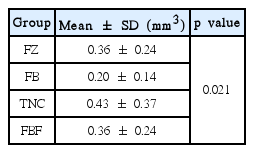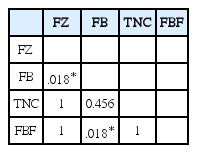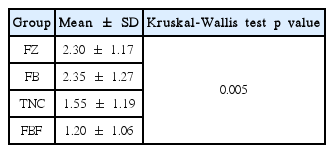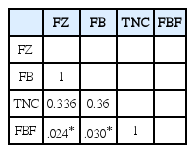유구치 2급 와동에서 bulk-fill 복합레진의 와동적합성 평가
Evaluation of Cavity Wall Adaptation of Bulk-fill Resin Composites in Class II Cavities of Primary Molar
Article information
Abstract
최근 개발된 bulk-fill 복합레진에 대한 연구가 많이 이루어지고 있지만 소아환자 치료에 사용할 수 있는 적절한 재료인지에 대한 연구는 부족한 실정이다. 따라서 본 연구의 목적은 유구치의 2급 와동에서 bulk-fill 복합레진과 전통적 복합레진의 와동 적합성을 비교평가하는 것이다.
발치 된 80개의 유구치의 근심 또는 원심에 2급 와동을 형성한 후 4개의 군으로 무작위로 나누었다. 대조군은 전통적 복합레진인 FiltekTM Z-350 XT(FZ)으로 수복하고 나머지 3개의 군은 bulk-fill 복합레진인 FiltekTM Bulk Fill Posterior Restorative(FB), Tetric N-Ceram® BulkFill(TNC)과 FiltekTM Bulk Fill Flowable Restorative(FBF)으로 수복하였다. 모든 시편을 열순환 시행한 후 50% 질산은(AgNO3)용액에 침적시켰다. Micro-CT를 이용하여 전체 질산은의 침투 부피와 치경부의 변연누출 정도를 측정하였고 기포의 개수, 크기, 위치를 평가하였다.
질산은의 침투 부피에서 FB가 FZ보다 유의하게 낮은 값을 보였고(p < 0.05), TNC와 FBF는 FZ와 비슷한 값을 보였다. 치경부 부분의 변연누출 정도는 FBF가 FZ와 FB보다 유의하게 낮은 값을 보였다(p < 0.05). 기포의 개수와 크기는 4개 군 모두 유의한 차이가 없었으나 기포의 위치는 전통적 복합레진에서는 전체 기포의 83.3%가 수복물 내부에 분포하였고, bulk-fill 복합레진에서는 치은축면 선각에 많이 분포하였다. 유구치 2급 와동에서 bulk-fill 복합레진과 전통적 복합레진의 와동에 대한 적합성은 유사한 결과를 보여주었다. 따라서 소아의 치아우식증 수복치료 시 bulk-fill 복합레진이 유용하게 사용될 수 있을 것으로 보인다.
Trans Abstract
Recently, there have been many studies on bulk-fill resin composites. However, studies on the proper materials for pediatric patients are rare. The aim of this study was to compare the cavity wall adaptation of bulk-fill resin composites with conventional resin composite in class II cavities of primary molars using microcomputed tomography (micro-CT).
Standardized class II slot cavities were prepared in 80 exfoliated primary molars and randomly divided into 4 groups. The control group was restored with conventional resin composite, Filtek Z-350 XT (FZ), and the three groups were restored with bulk-fill resin composites, Filtek bulk-fill posterior (FB), Tetric N-Ceram Bulk Fill (TNC), Filtek bulk-fill flowable (FBF). All specimens were thermocycled and then immersed in 50% silver nitrate (AgNO3) solution. Micro-CT was used to measure the penetration volume of the total silver nitrate and the degree of cervical marginal leakage and the number, size, and position of the voids were evaluated.
The results revealed that the volume of silver nitrate were significantly different between FB and FZ (p < 0.05). The results also revealed that the penetration length of silver nitrate FBF showed statistically lower than the FZ and FB (p < 0.05). There was no significant difference between the groups in number and size of voids. In conventional resin composite, most of the voids were present inside the restoration (83.3%), but the voids in the bulk-fill resin composites incidence were higher in the gingivoaxial angle. The cavity wall adaptation demonstrated in class II restorations of primary molar by new bulk fill resin composites was similar to conventional incremental technique. Bulk-fill resin composites might be an clinical option for a faster restoration in deciduous teeth.
I. 서 론
Bowen[1]이 Bis-GMA(bisphenol-A-glycidyl methacrylate) 레진을 소개한 이래 수복재료로써 복합레진의 사용이 꾸준히 증가해왔으며 소아치과 영역에서도 복합레진 수복이 많은 비중을 차지하고 있다. 이와 관련하여 복합레진의 기계적, 물리적 성질의 개선이 이루어졌으나 중합수축의 문제를 완전히 해결하지 못함으로써 여전히 임상적 실패의 원인이 되고 있다. 복합레진의 중합수축은 충전물과 치아 사이의 미세누출을 일으키게 되고 미세누출은 변연착색, 이차우식, 술 후 민감증의 증가, 치수의 괴사와 치아의 파절 등의 원인을 제공하여 수복물의 실패를 가져온다[2,3]. 따라서 미세누출의 정도는 치과 수복물의 수명을 결정하는데 중요한 요인이 된다.
복합레진의 중합수축을 감소시키기 위한 방법으로 적층충전방식이 보편화 되어있다. 이는 한 번에 중합하는 복합레진의 깊이가 2 mm를 넘지 않도록 하여 configuration factor(C-factor)를 감소시켜 과도한 수축응력의 발생을 방지하여 줄 뿐만 아니라 각 층을 나누어 중합함으로써 충분한 광조사가 가능하다. 하지만 시간이 많이 소요되고 그에 따른 타액 오염 가능성이 증가하고 수복물 내로 기포가 함입될 위험성이 있다는 단점이 있으며 적층 충전 방식이 항상 수축응력을 완화시키는 것은 아니라는 주장이 제기되고 있다[4,5]. 특히 비협조적인 소아환자에서 복합레진 수복을 시행할 때 짧은 시간 내에 치료를 마쳐야 하므로 이러한 단점들은 더 두드러진다.
최근 복합레진의 술식 간소화의 요구에 따라 bulk-fill 복합레진이 소개되었다. Bulk-fill 복합레진은 한 번에 4 - 5 mm 두께의 충전이 가능하며 전통적 복합레진의 이장재 또는 기저재뿐만 아니라 단독 수복 재료로 사용 가능하다. 이것은 반투명성의 증가 및 광에 대한 높은 반응성과 관련이 있으며, 중합수축 응력 이완제와 중합 조절제 등을 이용하여 중합수축을 감소시켰기 때문이다[6]. Bulk-fill 복합레진의 물리적, 기계적 성질이 전통적 복합레진에 견줄만하다는 여러 연구 결과가 보고되고 있다[7-9]. 이러한 bulk-fill 충전은 깊고 넓은 와동의 수복 과정을 간소화시키고 술식 시간을 단축시켜 줄 수 있다.
수복 재료의 물리적, 기계적 성질, 편리성, 술식 시간 단축 등의 특성이 중요하지만 와동 벽에 대한 재료의 적합성이 장기적인 임상적 성공과 관련성이 높다. 기존의 bulk-fill 복합레진에 대한 연구는 대부분 영구치를 대상으로 평가하였고 유치에 대한 연구는 미비한 실정이다[10-13].
수복물의 변연누출 평가에는 색소침투법 등을 비롯한 여러 방법이 있지만 micro-computed tomography(micro-CT)는 작은 물체의 세밀한 부분까지 관찰이 가능한 비파괴적인 방법으로 내부 구성성분을 3차원 이미지로 재현할 수 있다[14]. 이 방법은 치아에 형성한 와동과 수복물 간에 발생한 변연누출을 통해 흘러 들어간 질산은을 방사선 사진을 이용하여 촬영하고 그 영상을 디지털화하여 질산은이 나타내는 부위를 정량 분석할 수 있다[12]. 따라서 와동 수복물의 변연누출과 기포 유입을 평가하는데 있어 micro-CT가 전통적 염색법에 비해 표준화되고 신뢰도가 높은 방법이다[15].
본 연구의 목적은 유구치의 2급 와동에서 bulk-fill 복합레진과 전통적 복합레진의 와동에 대한 적합성을 micro-CT를 이용하여 비교 평가하는 것이다.
Ⅱ. 연구 재료 및 방법
본 연구는 부산대학교 치과병원 기관윤리심의위원회(Institutional Review Board, IRB)의 승인을 받아 시행되었다(IRB NO. : PNUDH-2016-009).
1. 연구 재료
최근 6개월 이내에 자연 탈락시기에 발치한 제2유구치 중 건전한 협, 설면을 가지고 교합면 우식이나 파절, 또는 수복물이 존재하지 않는 80개의 치아를 연구 대상으로 하였다. Bulk-fill 복합레진은 FiltekTM Bulk Fill Posterior Restorative(3M ESPE, USA), Tetric® N-Ceram Bulk fill(Ivoclar vivadent, Germany)와 FiltekTM Bulk Fill Flowable Restorative(3M ESPE, USA)를 선택하였고 대조군으로 전통적 복합레진인 Filtek Z-350TM XT(3M ESPE, USA)을 사용하였다(Table 1). 상아질 접착제로는 G-PremioTM Bond(GC, Tokyo, Japan)를 사용하였다(Table 2).
2. 실험 방법
(1) 대상 치아의 준비 및 와동형성
선정된 치아를 아크릴릭레진에 매몰하였다. 이때 발거 된 유구치의 치근이 짧아 매몰의 편의성을 위해 복합레진을 이용하여 원형의 기둥을 만들어 매몰하였다.
고속엔진용 #553 carbide fissure bur를 이용해 충분한 주수하에 각 치아 당 1개의 근심 또는 원심 2급 와동을 slot 형태로 bevel 없이 80개 형성하였다. 와동의 크기는 치아의 교합면에서 협설측 너비는 3 mm, 근원심 폭경은 2 mm, 깊이는 4 mm, 와연우각은 90°가 되도록 형성하였으며 모든 내부선각은 부드럽게 하였다. 이때 모든 와동의 크기는 caliper를 이용하여 측정하였으면 5개의 와동마다 새로운 버를 사용하였다.
(2) 접착제의 적용 및 복합 레진 충전
형성된 와동을 무작위로 20개씩 4개의 군으로 분류하였다(n = 20). 제1대구치 교정용 밴드 중 시편 크기에 맞는 밴드를 골라 장착하여 인접면 형태를 재현하였다. 준비된 와동에 상아질 접착제를 제조사의 지시대로 도포한 후 해당 복합레진을 충전하였다(Table 2). 이때 전통적 복합레진인 FZ군에서는 2 mm씩 2회 수평 적층충전하였으며, bulk-fill 복합레진인 FB, TNC, FBF군에서는 4 mm의 단일층으로 충전하였다. 광조사에는 광도가 1000 mW/cm2인 LED 광중합기(VALO®, Ultradent Products, South Jordan, UT)를 이용하였다. FZ군에서는 1회 충전 후 40초간 교합면 방향에서만 조사하였고 2회 충전 시에는 교합면 방향에서 20초간 조사한 후 교정용 밴드를 제거하고 다시 교합면 방향에서 20초간 광조사하였다. Bulk-fill 복합레진군에서는 단일층 충전 후 교합면 방향에서 20초간 광조사 한 뒤 밴드를 제거하고 다시 교합면에서 20초간 광조사하였다. 중합 후 polishing disk(Sof-Lex, 3M ESPE, USA)를 이용하여 수복물의 변연을 정리하고 충전한 시편은 상온에서 24시간 동안 증류수에 보관하였다.
(3) 열 순환 및 질산은 침척
수복한 시편은 5 ± 2℃와 55 ± 2℃에서 각각 30초씩 침적시키는 방법으로 500회의 열순환을 시행하였다. 열 순환 시킨 시편은 와동변연의 1 mm를 제외한 모든 표면을 nail varnish로 2회 도포, 건조하였다. 이후 50% 질산은(AgNO3)이 담긴 용기에 24시간 침지한 후 시편을 흐르는 물에 세척하여 질산은을 제거하였다.
(4) Micro-CT 촬영 및 분석
Micro-CT 촬영은 Inspexio SMX-90CT(SHIMADZU, Japan)를 이용하였으며 촬영 조건은 90 kV, 109 μA로 설정하였다. 촬영한 원본 데이터는 이미지 분석 프로그램(VG studio 2.2, Volume Graphics, Germany)을 이용해 이차원 평면과 삼차원적 이미지로 재구성하였다.
재구성된 이미지에서 변연누출과 기포 형성부분을 면밀히 관찰하였다. 변연누출은 전체와 치경부 부분으로 나눠 평가했다. 이때 전체 변연누출은 수복물의 모든 변연으로 침투된 질산은의 총 부피를 측정하여 평가하였다(Fig. 1). 3차원으로 재구성한 이미지에서 volume rendering 기능을 이용하여 치질과 수복물의 이미지를 지우게 되면 침투된 질산은 이미지만 남길 수 있다. 이렇게 남은 질산은 부피를 정량적으로 측정하였다. 치경부 변연누출은 이차원적 이미지에서 치경부 부분에 질산은이 침투된 정도를 Table 3의 기준을 이용하여 점수화하였다.

Marginal leakage assessment (A) 2D image from a FB sample of the penetrant along the tooth - restoration interface. (B) reconstructed 3D images (C) 3D rendering of the silver nitrate penetrant using the subtracted image stack.
기포형성 정도는 이차원 이미지에서 기포의 개수, 크기와 위치를 조사하여 평가하였다. 기포의 크기는 시편의 axial, sagittal, coronal 2차원적 이미지에서 가장 긴 지름을 caliper 기능을 이용하여 측정하였다. 기포의 위치는 크게 수복물 내부, gingivoaxial angle 과 그 외로 나눠서 조사하였다(Fig. 2).
(5) 통계
각 재료에 따른 변연누출의 정도, 기포의 크기와 개수 차이의 검증은 Kruskal-Wallis test를 이용하였으며, 사후검정을 위해 Mann-Whitney’s U test를 실시하였다. 이 때, 다중 비교 시 Bonferroni 방법에 의해 보정된 유의수준(Bonferroni-corrected p value)을 이용하였다. 정규성 검정은 Kolmogorov- Smirnov’s test를 수행하였다. 각 재료에 따른 기포 위치 비교에는 Fisher’s exact test를 이용하였다. 모든 통계분석은 SPSS 23.0 분석 프로그램을 이용하였으며, 유의수준은 0.05로 설정하였다.
Ⅲ. 연구 성적
1. 변연누출
1) 전체 변연누출 부피
Bulk-fill 복합레진인 FB의 평균 변연누출이 가장 적었으며 TNC의 평균 변연누출이 가장 많았다(Table 4). 각 군간 변연누출의 비교에서 FB가 FZ, FBF와 통계적 유의차를 보였다(Table 5).

Mean volume of silver nitrate penetration (mm3) along the margin in class II preparations of primary molar restored with composite resin
2. 기포 형성
기포의 수와 크기는 FBF가 가장 작았으나 4개 그룹 모두 통계적 유의차가 없었다(Table 8, 9). 그러나 기포의 위치는 bulk-fill 복합레진과 전통적 복합레진 사이에 차이가 존재했다(Table 10). 각 재료에 따른 기포의 위치에 차이가 있는지를 검정하기 위해 Fisher’s exact test를 시행한 결과, 적층충전을 시행한 FZ에서는 수복물 내부에 발생한 비율이 83.3%로 가장 높았다. Bulk-fill로 충전한 FB에서는 수복물 내부 발생 비율이 53.1%로 가장 높게 나타났으나 gingivoaxial angle에 발생한 비율이 FB, TNC, FBF에서 각각 40.6%, 57.7%, 68.8%로 높은 것으로 나타나 기포 위치의 양상에 차이가 있는 것을 알 수 있다(p < 0.05).
Ⅳ. 고 찰
우수한 와동 적합성은 수복물의 지속성을 증가시키는데 필수적이다[16]. 이번 연구는 유구치의 2급 와동에서 bulk-fill 복합레진과 전통적 복합레진의 와동적합성을 micro-CT를 이용하여 비교 평가하였다. 여기서 와동적합성은 변연누출과 기포형성 정도를 조사하여 평가하였다.
복합레진 수복물에서 gap 형성은 중합수축과 비례하며 중합 수축 스트레스가 높을수록 미세누출이 증가한다. 중합 수축은 복합레진 수복 실패의 가장 흔한 원인이다. 중합 수축의 원인은 치질 경계의 상태, 재료의 성분과 재료의 중합 반응의 정도 등과 같이 여러 가지가 있다[17]. 중합이 일어나면 단량체가 고분자 네트워크로 전환되면서 van der Walls 공간이 공유결합 공간으로 바뀌게 되고 이 과정으로 레진 성분사이에 수축력이 발생하고 미세누출이 일어난다[18].
Bulk filling이 가능한 것은 bulk-fill 복합레진에 포함된 광개시제의 발전과 함께, 무기질 필러의 함량은 적어지고 크기는 커졌기 때문이다. 필러의 크기를 크게 하면 투명도가 증가하여 광투과도가 증가하고 이에 따라 더 깊게 중합이 가능하다[19]. 따라서 bulk-fill 복합레진은 hybrid 복합레진이나 유동성 복합레진보다 낮은 중합수축응력을 보이며 수축률도 낮다고 알려져 있다[20]. Bulk-fill 복합레진의 경우 초기 중합속도가 느려 흐름성을 유지할 수 있고, 이는 전통적 복합레진에 비해 수축이 감소되는 이유이다[21].
복합레진의 methacrylate 복합체는 중합 과정 중 수축되는 고유의 성질이 있고 수축의 정도는 사용되는 단량체에 따라 변할 수 있다. 이번 연구에서는 bulk-fill 복합레진으로 Filtek Bulk fill Posterior Restorative(FB), Tetric N-Ceram Bulk Fill(TNC), Filtek Bulk fill Flowable Restorative(FBF)를 사용하였다. FB의 경우 반응기를 감소시키는 aromatic urethane dimethacrylate(AUDMA)와 성장 중인 polymer 내에서 반응하여 인접한 polymer 사슬과 가교를 형성하는 additional-fragmentation monomer(AFM)의 조합이 중합 스트레스를 감소시키는 역할을 한다. TNC는 표준개시제 시스템에 Ivocerin이라는 새로운 광중합 개시제를 추가하여 중합 효율과 중합 깊이가 증가되었고, 중합수축응력 이완제 및 미리 중합된 필러의 사용이 탄성계수를 낮추어 중합수축응력을 감소시켰다[22]. FBF는 저점도 bulk-fill 복합레진으로 분자량이 큰 단량체를 이용하여 흐름성을 증가시키면서 중합 수축을 감소시켰다.
이번 연구에서 변연누출에 대한 부분을 전체와 치경부 부분으로 구분하여 평가하였다. 전체 변연누출은 질산은의 침투 부피를 정량적으로 측정하였는데, bulk-fill 복합레진인 FB가 가장 적은 값을 보였으며 각 군간 비교에서는 FB가 FZ, FBF보다 유의하게 낮은 값을 보였다(p < 0.05). Moorthy 등[10]의 연구에서는 bulk-fill 복합레진과 전통적 복합레진의 미세누출 정도가 비슷하게 나왔다. Rengo 등[15]은 대구치 2급 와동에서 bulk-fill 복합레진의 미세누출 정도를 평가한 연구에서 bulk-fill 복합레진이 전통적 복합레진과 비슷한 결과를 보인다고 밝혔다. Gaintantzopoulou 등[23]의 유구치의 2급 와동에서 심미수복재료에 대한 와동적합성에 대한 연구에서 bulk-fill 복합레진의 미세누출 정도가 기존의 글래스아이오노머 재료보다 우수하거나 비슷한 결과를 보였다.
유치나 영구치에서 2급 와동 수복의 실패는 대부분 치은변연에 대한 적절한 봉쇄가 이루어지지 못했을 때 나타난다[24]. 특히 치경부 변연누출은 수복물의 실패와 관련성이 높으며 교합면의 변연누출 보다 더 많은 비율로 일어난다[25]. 그리고 많은 연구에 의하면 2급 복합레진 수복물의 치경부 변연이 법랑질에 위치하면 우수한 변연적합성을 보이지만 CEJ 하방에 위치하면 누출이 심하게 된다고 하였다[26]. 이는 법랑질에 비해 상아질이 유기물과 수분의 함량이 많으며 백악질의 유기물에는 상아질보다 거친 콜라겐 섬유를 함유하여 접착력이 약해지기 때문이다[27]. 또 다른 이유는 중합시 광조사 팁이 레진 표면에서 멀기 때문이라는 것이다. 광조사 팁과 레진 표면 사이의 거리가 2 mm 이상이면 광 강도가 급속하게 감소한다. 이러한 점이 복합레진의 적절한 중합을 방해할 수 있다[28].
이번 연구에서는 전형적 2급 slot 와동을 형성하였고 이때 치경부 변연은 법랑질에 위치하게 하였다. 치경부 변연누출은 bulk-fill 복합레진 중 flowable 형태의 FBF가 FZ와 FB보다 통계적으로 유의하게 낮은 값을 보였다(p < 0.05). Scotti 등[29]의 연구에서 나온 bulk-fill flowable 복합레진이 치경부 변연에서의 우수한 적합성을 보인다는 결과는 이번 연구의 결과와 일치하였다. 하지만 Campos 등[30]의 연구에서는 bulk-fill 복합레진의 치경부 변연누출 정도가 전통적 복합레진에 비해 높다고 나왔다.
이전 연구들에서는 기포의 유무나 기포의 부피를 측정했지만 이번 연구처럼 기포 형성에 대해 구체적으로 조사한 연구는 없었다. 이번 연구에서는 bulk-fill 복합레진의 와동에 대한 적합성으로 기포의 크기, 개수, 위치도 평가하였다. 기포는 일차적으로 수복 시 기계적 공기 유입에 의해 발생한다. High viscosity 복합레진의 경우 레진을 packing 하는 과정에 유입되고 low viscosity 복합레진의 경우 dispenser에서 와동으로 들어갈 때 레진 기질이 재배열되면서 기포가 형성될 수 있다. 이때 발생한 기포는 불량한 변연적합과 관계가 있으며 이는 치질과수복물 사이의 결합력을 감소시킬 수 있다[31]. 이번 연구에서 기포의 개수와 크기는 bulk-fill 복합레진인 FBF에서 가장 낮은 값을 보였으나 다른 군과의 통계적 유의차는 보이지 않았다(p > 0.05). Nazari 등[32]의 연구에서는 bulk-fill 복합레진인 SDR의 내부에서 기포의 부피가 가장 작게 조사되었으며 기존 복합레진보다 유의하게 낮은 값을 보였다.
적층충전을 시행한 전통적 복합레진인 FZ군에서는 대부분의 기포가 수복물 내부에 존재했으며 bulk-filling을 한 FB, TNC, FBF군에서는 gingivoaxial angle에서 높은 비율로 발견되었다. 이는 적층 충전 시 기존 레진 층과 새로운 레진 층 사이에 공기가 유입되면서 수복물 내부에 기포가 발생하기 때문이다. Bulk-filling시에는 복합레진의 충전 과정 중 공기가 유입되어 기포가 발생하고 gingivoaxial angle 부위처럼 깊은 부위까지 압력이 전해지지 못하여 레진이 덜 채워져 공극이 발생한다. 따라서 보다 조심스러운 레진 주입이 요구된다.
이번 연구에서는 유구치 2급 와동에서 bulk-fill 복합레진의 와동 적합성을 변연누출과 기포 형성을 조사하여 평가하였다. 변연누출을 전체 변연누출과 치경부 변연누출로 나눠서 측정했으나 치경부 부위의 변연누출 정도를 정량적으로 분석하지 못했다. 또한 치경부 변연을 법랑질 상에만 형성하여 상아질에서의 변연누출 정도를 평가하지 못했다는 한계점이 있으므로 이와 관련한 추가적인 연구가 필요할 것으로 사료된다. 또한 기포의 크기 측정 시 2차원 이미지에서 가장 긴 지름을 기준으로 측정하였다. 이 방법은 기포의 부피 측정에 비해 정확도가 떨어질 수 있다는 한계점이 있을 수 있으므로 이에 대한 추후의 연구가 필요할 것으로 생각된다.
이번 연구에서 bulk-fill 복합레진의 와동에 대한 적합성이 전통적 복합레진과 비슷하다는 결과를 보여주었다. 이는 bulk-fill 복합레진이 기존의 적층 술식에 비해서 시간을 단축할 수 있으며 비슷한 임상 결과를 보여줄 수 있을 것으로 생각된다. 따라서 소아치과 임상에서의 bulk-fill 복합레진의 활용도가 높을 것으로 사료된다.
Ⅴ. 결 론
이번 연구에서는 유구치의 2급 와동에서 bulk-fill 복합레진의 와동 적합성을 전통적 복합레진과 비교 평가하였다. 질산은의 전체 침투 부피는 bulk-fill 복합레진인 FB가 FZ와 FBF보다 유의하게 작게 나타났고(p < 0.05), 치경부 변연 누출은 FBF가 FZ와 FB보다 작게 나타났다. 기포의 개수와 크기는 각 군간 통계적 유의차는 없었다(p > 0.05). 적층충전을 시행한 전통적 복합레진에서는 기포의 대부분이 수복물 내부에 존재했지만 bulk-fill 복합레진에서는 gingivoaxial angle 부분에 많은 비율로 존재했다. 이번 연구결과에서 bulk-fill 복합레진의 와동적합성은 전통적 복합레진과 견줄만하다고 할 수 있다. 따라서 bulk-fill 복합레진은 유구치의 우식 치료 시 빠르고 간편하게 수복할 수 있는 재료로 사용할 수 있을 것으로 사료된다.









